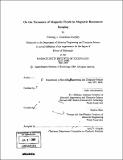On the dynamics of magnetic fluids in magnetic resonance imaging
Author(s)
Cantillon-Murphy, Pádraig J
DownloadFull printable version (41.57Mb)
Other Contributors
Massachusetts Institute of Technology. Dept. of Electrical Engineering and Computer Science.
Advisor
Elfar Adalsteinsson and Markus Zahn.
Terms of use
Metadata
Show full item recordAbstract
The hydrodynamics of magnetic fluids, often termed ferrofluids, has been an active area of research since the mid 1960s. However, it is only in the past twenty years that these fluids have begun to be used in magnetic resonance imaging (MRI) where they have found application as contrast agents, improving the contrast to noise ratio of the received MR intensity. The major goal of this work was to assess the feasibility of modulating the signal intensity in MRI in regions near superparamagnetic iron oxide contrast agents by applying a rotating magnetic field. Analytical study and numerical simulations of the effects of such a rotating magnetic field are presented. Simulated variations in fluid magnetization are achieved by changing the frequency of the rotating magnetic field. A linearization of the equilibrium magnetization Langevin relation results in a small signal magnetic susceptibility tensor that can be used to influence fluid flow. The feasibility of the approach under the real-life constraints of MR imaging are assessed. Also examined is the potential for coupling changes in magnetization due to rotating fields with hypothermia treatment of cancerous tissue. In addition to theoretical and simulated analysis, considerable experimental work was undertaken at the MRI systems of the HST Athinoula A. Martinos Center for Biomedical Imaging at Massachusetts General Hospital, Charlestown, Massachusetts. This work evaluated the passive behavior of both commercial ferrofluids and MRI contrast agents. The ability of MRI to serve as a highly accurate indicator of the fluid's physical and magnetic properties is shown. The thesis represents the first investigation into the use of the hydrodynamic properties of magnetic fluid in the presence of a rotating field as a mechanism for contrast in MRI. The results show the possibility of varying MR image intensity under careful selection of field conditions.
Description
Thesis (Ph. D.)--Massachusetts Institute of Technology, Dept. of Electrical Engineering and Computer Science, 2008. Includes bibliographical references (p. 219-233).
Date issued
2008Department
Massachusetts Institute of Technology. Department of Electrical Engineering and Computer SciencePublisher
Massachusetts Institute of Technology
Keywords
Electrical Engineering and Computer Science.